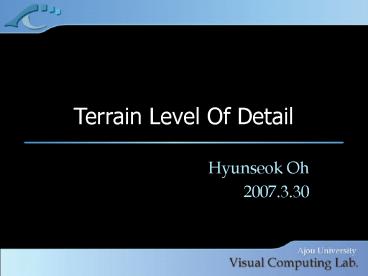Terrain Level Of Detail - PowerPoint PPT Presentation
1 / 21
Title:
Terrain Level Of Detail
Description:
Screenshot of the Grand Canyon with debug view using the Digital Dawn ... Easy view culling and collision detection. TINs. Triangulated Irregular Networks. ... – PowerPoint PPT presentation
Number of Views:58
Avg rating:3.0/5.0
Title: Terrain Level Of Detail
1
Terrain Level Of Detail
- Hyunseok Oh
- 2007.3.30
2
Contents
- Terrain LOD
- Background
- History
- Applications
- Data sizes
- Important Concepts
- Regular grids vs TINs
- Quadtrees vs Bintrees
- Crack,T-Junctions
- Out-of-core paging
- Related Works
- ROAM
- Research Plans
3
Terrain LOD
- LOD
- Terrain LOD
- General LOD vs Terrain LOD
- Easier
- Constrained geometry (generally).
- More specialized and simpler algorithms.
- Harder
- Continuous and large models.
- Simultaneously very close and far away.
- Necessitates view-dependent LOD.
- Out-of-core.
4
Terrain LOD Example
Screenshot of the Grand Canyon with debug view
using the Digital Dawn Toolkit.
5
Background
- History
- Sustained RD since the 1970s.
- The first system to use LOD Flight simulators.
- Applications
- Visual tourism travel planning.
- Education geographical general reference.
- Planning land panning/land usage, urban
planning. - Terrain-based computer games.
- Geographic Information Systems (GIS).
- Military mission planning applications.
6
Large Terrain Databases
- USGS GTOPO30
- 30 arc-second (1 km) resolution elevation.
- 43,200 x 21,600 1.8 billion triangles.
- NASA EOS satellite ASTER
- 30-m resolution elevation data.
- from 15-m near infrared stereo imagery.
- USGS National Elevation Dataset (NED)
- 50,000 quads at around 50 GB.
7
Regular Grids
- Uniform array of height values.
- Simple to store and manipulate.
- Encode in raster formats (DEM, GeoTIFF).
- Easy to interpolate to find elevations.
- Less disk/memory (only store z value).
- Easy view culling and collision detection.
8
TINs
- Triangulated Irregular Networks.
- Fewer polygons needed to attain required
accuracy. - Higher sampling in bumpy regions and coarser in
flat ones. - Can model maxima, minima, ridges, valleys,
overhangs, caves.
9
LOD Hierarchy Structures
QuadTree Hierarchy
BinTree Hierarchy
10
Quadtrees
- Each quad is actually two triangles.
- Produces cracks and T-junctions.
- Easy to implement.
- Good for out-of-core operation.
11
Bintrees
- Terminology
- binary triangle tree (bintree, bintritree, BTT).
- longest edge bisection.
- Easier to avoid cracks and T-junctions.
- Neighbor is never more than 1 level away.
12
Cracks and T-Junctions
- Avoid cracks
- Force cracks into T-junctions / remove floating
vertex. - Fill cracks with extra triangles.
- Avoid T-junctions
- Continue to simplify.
- Forced spiltting.
13
Out-of-core operation
- Virtual memory solutions
- mmap() used by Lindstrom 01.
- VirtualAlloc() / VirtualFree() used by Hoppe 98.
- Explicit paging from disk
- NPSNET (NPS) Falby 93.
- VGIS (GVU) Davis 99.
- OpenGL Performer Active Surface Def (ASD).
- SGI InfiniteReality (IR) Clipmapping.
14
Related Works
- Papers.
- Right Triangular Irregular Networks , 1997.
- ROAMing Terrain Real-time Optimally Adapting
Meshes, 1997. - Real-Time Generation of Continuous Levels of
Detail for Height Fields, 1998. - Terrain Rendering at High Levels of Detail (pdf),
2000 . - A Fast Algorithm For Large Scale Terrain
Walkthrough, 2001 (pdf) . - Visualization of Large Terrains Made Easy, 2001 .
- Diamond Terrain Algorithm CLOD for Height
Fields, 2001 . - Real-time Terrain Rendering using Smooth Hardware
Optimized Level of Detail, 2003 pdf. - Planet-Sized Batched Dynamic Adaptive Meshes
(P-BDAM), IEEE Visualization 2003. - Geometry clipmaps Terrain rendering using nested
regular grids. Siggraph 2004. - Rendering Procedural Terrain by Geometry Image
Warping. Eurographics 2004. - Adaptive Streaming and Rendering of Large
Terrains using Strip Masks, 2005. - Terrain Rendering Engine (TRE) Cell Broadband
Engine Optimized Real-time Ray-caster, 2005. - GPU-Friendly High-Quality Terrain Rendering
Journal of WSCG 2006. - Terrain Rendering using Spherical Clipmaps,
Eurographics 2006. - Seamless Patches for GPU-Based Terrain Rendering,
WSCG 2007.
15
ROAM
- Real-Time Optimally Adapting Meshes.
- Mark Duchaineau, 1997 (LLNL).
- Binary Triangle Tree Structure.
- No need to worry about cracks, etc.
- Can specify the desired number of triangles.
Example of ROAM terrain.
16
ROAM
- Main Concepts
- Split and Merge.
- Two priority queues.
- One for splits and one for merge.
- Allows for frame-to-frame coherence.
- Error Metrics for Splits and Merges.
- Incremental triangle stripping introduced.
17
ROAM
- Splitting and Merging diamonds.
18
ROAM
- Avoiding T-junctions.
19
ROAM Priority Queues
- One priority queue for splits, one for merges,
and use a greedy algorithm to triangulate. - Priority error metric( using wedgies ).
Illustrating nested ROAM wedgies for the 1D case.
20
Research Plans
- 4.20 - Survey papers select a paper.
- 5.31 Implementation.
21
References
- http//www.vterrain.org
- David Luebke et al. Level of Detail for 3D
Graphics. p185-228, Morgan Kaufmann, 2003.































